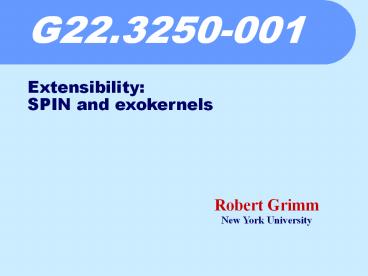G22.3250-001 - PowerPoint PPT Presentation
1 / 25
Title:
G22.3250-001
Description:
... high-level abstractions. Hurt application performance. Hide information. Limit ... Can we pass capabilities to user-land? Protection domains. Language-level ... – PowerPoint PPT presentation
Number of Views:14
Avg rating:3.0/5.0
Title: G22.3250-001
1
G22.3250-001
ExtensibilitySPIN and exokernels
- Robert Grimm
- New York University
2
Preliminaries
- Please remember one reading summary per paper!
- Reviews are an essential component of this class
- Project, milestone 1
- Due 2/8/05 before class
- PDF, emailed to me
- Project proposal and related work in one (3
pages) - What is the problem? Why does it matter?
- What is your overall solution? What are
non-goals? - What resource do you need?
- What have others done in that domain and related
domains?
3
The Three Questions
- What is the problem?
- What is new or different?
- What are the contributions and limitations?
4
OS Abstraction Barrier
- Fixed high-level abstractions
- Hurt application performance
- Hide information
- Limit functionality
- Examples
- Buffer cache management
- Persistent storage
5
Goals
- Extensibility
- Applications introduce specialized services
- Safety
- Kernel, applications, services are protected
- Performance
- Extensibility and safety have low cost
6
Why Is This Hard?
7
Two Approaches
8
SPIN Approach
- Put extension code in the kernel
- Cheap communication
- Use language protection features
- Static safety
- Dynamically impose on any service
- Fine-grained extensibility
9
The Big Picture
10
Modula-3
- Type-safe programming language
- Interfaces
- Garbage collection
- Other features
- Objects, generic interfaces, threads, exceptions
- Most of kernel written in Modula-3
- Drivers borrowed from DEC OSF/1
- Extensions must be written in Modula-3
- User-space applications written in any language
11
Safety
- Capabilities
- Simply a pointer
- Can we pass capabilities to user-land?
- Protection domains
- Language-level
- Limit visibility of names
- Enforced at dynamic link time
12
Extensibility
- Extension model
- Events
- Indicate the occurrence of some condition
- Event handlers
- May execute synchronously, asynchronously, or in
bounded time - Guards
- Restrict invocation of event handlers based on
arguments - Mechanism
- Event dispatcher
- Common case an (indirect) procedure call
- Module implementing the interface
13
Core Services
- Memory management
- Physical addresses
- Virtual addresses
- Translations
- Thread management
- Signals to scheduler
- Block, unblock
- Signals to thread manager
- Checkpoint, resume
14
Performance
- It works
15
Exokernels Approach
- Make the application do it!
16
Exokernels Approach (again)
- Separate protection and management
- Expose allocation
- Expose names
- Expose revocation
- Expose information
17
The Big Picture
18
At The Core
Aegis MIPS-based DECstations Xok x86-based
PCs
- Processor time slices
- Processor environments
- Hardware exceptions (Aegis, Xok)
- Timer interrupts (Aegis, Xok)
- Protected entries (Aegis, Xok)
- Addressing
- Aegis Guaranteed mappings, applications notified
of TLB misses - Xok Hardware page tables, applications specify
mappings - Hierarchical capabilities (Xok only)
- Book keeping
19
How to Protect Shared Abstractions?
- Software regions
- Provide access to memory only through system
calls - Are typically more fine-grained than pages
- Hierarchically-named capabilities
- Easily restrict access
- Wakeup predicates
- Ensure that processes get their time in the
limelight - Robust critical sections
- Provides isolation with low overhead and without
requiring cooperation
20
Separate Protection and Management The Disk
- Problem
- How to store meta-data?
- Ownership of disk blocks
- Failed approaches
- Simple capabilities
- Where to put the capabilities? In the block? A
separate area? - Self-descriptive meta-data
- How expressive is the description language?
- How much space is used for descriptions?
- Template-based descriptions
- Again, how expressive is the description language?
21
The Disk (cont.)
- Untrusted deterministic functions
- Programmatic templates that specify pointed-to
blocks - Shared data
- System-wide buffer cache registry
- Entries can be locked
- Ordered disk writes
- Ensure consistency after crash
- Never reuse on-disk resource before nullifying
pointers - Never create pointers before pointed-to data has
been initialized - Never reset old pointer before new one has been
set
22
Performance
- It works
- It scales
23
Issues
- SPIN
- Trusted compiler
- Resource control
24
Issues (cont.)
- Exokernels
- Extension model
- Downloaded code
- Wakeup predicates
- Dynamic packet filters
- Application-specific handlers
- Untrusted deterministic functions
- Complexity of disk management
25
What Do You Think?











![READ[PDF] 1,001 Dot-to-Dot Amazing Animals PowerPoint PPT Presentation](https://s3.amazonaws.com/images.powershow.com/10099687.th0.jpg?_=20240815086)

![[Latest Update] CompTIA CD0-001 Actual Exam Practice Questions Shared Online PowerPoint PPT Presentation](https://s3.amazonaws.com/images.powershow.com/10140961.th0.jpg?_=20240927016)

















